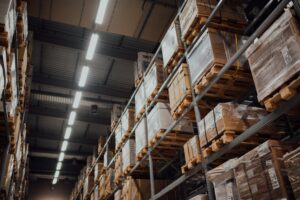How To Choose Industrial Lighting
Posted by Emma Reid on 7th Jun 2022

Warehouses, factories, kitchens and car parks, there are loads of commercial sites that need tough, reliable lighting! Here’s our guide to industrial lighting, and why LEDs could be just what your business needs.
What Are The Challenges Of Industrial Lighting?
- Industrial spaces tend to feature high ceilings and open designs, so they need really bright light to ensure good coverage. This can get expensive!
- The tasks performed in industrial spaces tend to be detail-oriented and with a higher risk of injury than tasks in other regions. Bright lighting is needed to maximise safety and efficiency.
- Industrial lighting may be exposed to harsh conditions, including extreme temperatures,
- Industrial lighting may be exposed to heavy duty machinery, so it needs to be impact resistant.
- In some cases, you may need to consider hygiene practices, and will have to protect consumable items from contamination if your light breaks.
- Electrical noise is also a factor. Low quality lighting can cause damage to equipment, and vice versa.
- In some situations, you may require emergency lighting capabilities to maximise safety.
- Industrial lighting is typically divided into two categories, area lighting and task lighting. High bay lights and other large general-purpose lights are best for the former. Task lighting focuses on smaller areas.
Obviously, not all of these factors will apply to every commercial site, but these are good factors to keep in mind. So what do we need to look for
1) IP And IK Ratings
IK and IP ratings are a great way to understand at a glance how durable a light is. IP ratings represent how resistant a light is to moisture and objects of varying sizes- the higher the number the better! The first digit represents protection against solids, while the second represents protection against liquids.
IP67 means your fitting is protected from dust and water (even allowing temporary immersion) so it’s a great option for most industrial applications.
If you’re working in an area where regular deep sanitising is required (particularly through high pressure water jets) then an IP69K may be more appropriate.
For sites with a lot of gas vapour (such as a warehouse lorries and other vehicles get used in regularly) you may also want to look for ‘non-corrosive’ fittings, such as our Fortress 25W-80W LED Non-Corrosive IP65 Tridonic Driver Fitting.
Industrial lighting doesn’t just need to avoid moisture and dust, it also needs to be resistant to impacts. The IK rating will tell you about this. Again, the higher the number the better.
One smaller durability factor is how your lights cope with constant vibration. If you have a lot of heavy machinery in operation, the entire building can vibrate in a way that people don’t notice- but fittings definitely do!
As a rule of thumb, filament bulbs are very fragile, as they feature very delicate components.
CFL bulbs are a little more durable, but the main concern with them is that if they do break, this becomes a major health and safety hazard, due to toxic mercury vapour.
LEDs are incredible durable as they do not use glass or filaments, and they’re totally safe if they break.
2) Extreme Temperatures
LEDs are much better at dealing with cold compared with traditional lights, with many able to continue functioning in temperatures as low as -40°C. This makes them a great choice for refrigerated warehouses!
With heat it’s a little more complicated, as older LEDs can be a little sensitive to high temperatures. They don’t get as hot as other lights (which actually makes them less of a fire risk), but being exposed to high temperatures can hamper lifespan and performance.
However, as the technology develops, designers are putting more emphasis on high quality housing that is better at dissipating heat, as well as other ways of mitigating this problem.
3) Performance And Cost
As mentioned, bright light is key to a safe working environment, but with large scale industrial buildings, this can quickly get pretty expensive in terms of energy bills. These bills are only set to increase, so getting the most efficient lighting possible is a key concern.
That’s where LEDs really come in, with their incredible 90% efficiency rates, you get incredibly bright lighting at a very low energy cost. That helps you and your business save money without compromising safety.
This efficiency also makes emergency batteries more effective, and typically able to last for longer!
As an added bonus, while the initial cost for entry may be a little higher with LEDs, a good quality LED can last you for more than a decade, so they offer up value for money over the course of a very long time.
If you’re looking to outfit an industrial space with high quality LEDs, get in touch with our team today! You can give us a ring on 0116 321 4120 or send an email to cs@wled.co.uk. You can also follow us on YouTube, Twitter, Instagram or Facebook.





